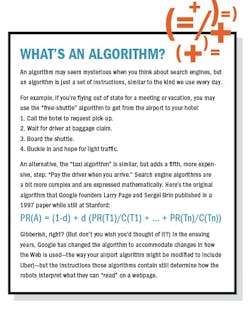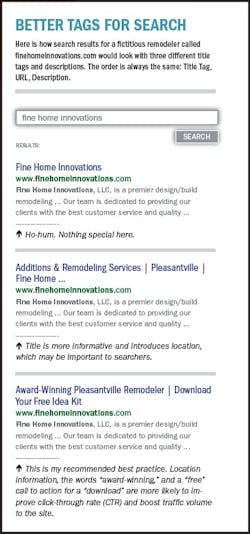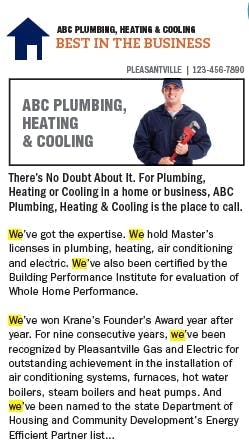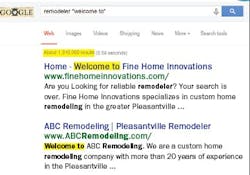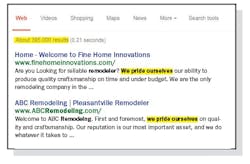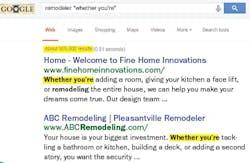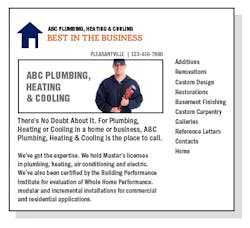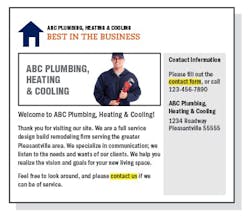SEO for Online Leads
With more and more homeowners using the Web to find design ideas, investigate projects, and ultimately locate a remodeling company to do the work, a remodeler’s website needs to function as a lead-generation machine. But to successfully generate qualified leads, your website has to attract attention from two audiences, humans and machines—homeowners looking for a contractor, and the robots that the digital search engines use to scour the Web. That means a website must be attractive to its human audience and provide them with a satisfying online experience, while also meeting the technical requirements of the machines that will ultimately judge how relevant it is to a particular homeowner’s search. Both audiences are equally important, but as a rule of thumb, you should write first for the people in your audience, then come back later and make sure that what you wrote makes sense to the machines that will also be “reading” your site.
Key SEO Factors
How well your website performs depends partly on SEO (search engine optimization). We’ve all heard the term SEO, but to really understand what it is and why it’s important, it helps to know a bit about how it works. Let’s start by thinking about what search engines such as Google actually do.
Google earns revenue based mainly on the quality of its search results, so it works hard to make sure that its rankings include the most relevant webpages given a particular set of search terms. How Google does this isn’t magic, it’s based on a type of mathematical formula called an “algorithm,” which is a fancy word for a predefined set of instructions (see “What’s an Algorithm?” below). What appears to searchers to be a “judgment” about the content of a website is in reality a literal execution of a detailed set of instructions based partly on how searchers use the results and what they do once they reach a website, but also based on the words that the machines find on your site.
Title tag and meta description.Which words, exactly? It starts with the title tag, which is the text that appears in the browser tab. The title tag displays by default, but if it’s missing, Google just uses the site URL. (Incidentally, underscores between words in a URL turn it into one, long, hard-to-decipher word. A hyphen or space between words gives Google better information and reduces errors.)
The meta description is the text that Google displays under the title tag on the results page. If Google finds the actual search terms anywhere on your site, it will display short excerpts that contain those terms; otherwise, it displays your meta description. Title and description used to be very important to help your site rank high in the results. But these days, Google can easily figure out what your site is about without them, so these words are mainly for the benefit of people who read the search results. The better the title and description, the more likely it is that people will click through to your website (scroll down to read “Better Tags for Search,” below).
Headings to structure content. Printed publications use fonts and type size to indicate relative importance of information and create points of entry for readers. In the same way, websites should use HTML “headings” to vary type size to create a hierarchy and establish priority. In code, headings are represented by “H-tags” numbered one through five in order of decreasing importance: <H1>, <H2>, … <H5>.
For more effective SEO, use H1-tags with your most important keywords, never duplicate a title tag in an H-tag, and use only one H1-tag per page. Generate a keyword cloud (many online sites, both free and paid, can do this) and use Google AdWords Keyword Planner to get an idea of the most frequently recurring keywords in user searches for companies with services like yours. They are likely to be the keywords that rank high in search results.
Keyword frequency. The frequency of keywords is a similar trigger. To improve the chance of ranking high in search results with specific keywords, you should use the most important keywords consistently in your content, title, description, and H-tags, as well as in things like anchor text. (Anchor text is the clickable text in a link to another page or another website. The linked words should always be relevant to the page that you’re linking to). Remember also that, like H-tags, bold or italicized type tells Google that the writer thinks the word is important.
Don’t overdo it, though. The kind of “keyword stuffing” that was popular a decade ago is now seriously frowned upon by Google and can result in a lower ranking or, in the worst cases, an outright ban from search results.
Image descriptions. You need to tell Google what’s in your photos. Google’s robots can find images on your pages, but they can’t “see” what’s in the image, so they don’t know what it’s about. To fix this, use an “alt attribute,” which is a text description that explains what’s in an image and enables Google to list the image in its image search results. Without alt-tags, a page of images may as well be blank as far as Google is concerned (see “7 Deadly SEO Sins”).
More pages are better. Google automatically indexes your site’s pages. The general rule is that the more pages you have, the better. This can backfire if the pages have marginal content or the content strays too far from your most important keywords. But page indexing is one reason why blogging is so important for your website. Blogging creates lots of relevant content to attract traffic, but it also ups the website page count (see “Yes, You Have to Blog”).
Inbound and outbound links. Back when Google started, it delivered better results than its many competitors largely because it used an algorithm that judged a website’s relevance to search terms by checking to see how many other websites pointed to it. The algorithm is much more complex today, but links, both incoming and outgoing, are still a big part of page rankings.
Outbound links are important because they provide value to your audience—but only if they work, so make sure you don’t have any broken links (there are a number of free sites that can do this for you). Then make sure that your outbound links point to relevant sites, and that the anchor text (the clickable words you use to link out) are relevant to the site that you are linking to.
Inbound links are equally important because they tell Google that others think your site’s content is important. But again, it’s important that the linking sites contain content that’s relevant to the content on your site. It’s hard to control inbound links, but you should encourage links from relevant sites that relate to your expertise—.edu or .org sites, such as the National Association of the Remodeling Industry, for example. And you should discourage links from unrelated sites. As with keyword stuffing, too many irrelevant inbound links can harm your ranking.
Getting the Words Right
Pushing all the right SEO buttons will make Google’s machines happy, but it won’t make a bit of difference if your site isn’t appealing to the flesh-and-blood people who land on it. This means that you need to use language that is persuasive. It’s not creative writing, and it’s not about SEO—it’s more like advertising or marketing copy: compelling and attention-getting. Copywriting is an art: I’ve been doing it for 10 years and though I consider myself above-average at it, I haven’t mastered it. Just as you would hire a professional Web designer to create an aesthetically appealing site, I recommend that you hire a professional copywriter to write your site.
“You.” One of those magic words is “you.” Take another look at the previous paragraph:
Think about how many leads you got last month. Imagine if you could triple that number by using three hypnotic words on your homepage. Would you do it? You probably don’t believe it’s possible. But I’m going to tell you that it is—because studies show that certain words trigger a subconscious emotional response. Imagine what this would do for your sales!
There’s nothing as stimulating to us as our own interests, desires, ambitions, goals, yearnings, and emotions. The psychological effect called Fundamental Attribution Error, which, simply put, means that while we are naturally critical of other people, our critical minds take a break when we evaluate ourselves.
“Imagine” and “Because.” Look at that paragraph again. The word “imagine,” which appears twice, has a powerful effect on most people. To the human brain, there’s no difference between visualizing a tree and seeing an actual tree. If you ask people to imagine a new kitchen or bath, you are giving them a psychological push to pull the trigger on the project.
“Because” is another trigger word used in the sample paragraph that has a profound effect on human behavior. Psychologist Robert Cialdini, in his book The Psychology of Persuasion, describes an experiment in which people using a copy machine were asked by a Cialdini collaborator if they could jump in front. Here are the three ways they asked, and the percentage of people who agreed to stop copying and let them jump in:
“Excuse me, I have five pages. May I use the Xerox machine?”
Sixty percent agreed.
“Excuse me, I have five pages. May I use the Xerox machine because I’m in a rush?” Ninety-four percent agreed.
“Excuse me, I have five pages. May I use the Xerox machine because I have to make some copies?” Ninety-three percent agreed!
The remarkable thing about the last example is that the reason is a tautology, but almost everyone still agreed. We humans need an answer to the question “Why?” Your site can’t just say “Choose us.” You need to provide unique and convincing reasons for visitors to take action.
Yes, You Have to Blog
I’m sorry, but if you want your website to generate leads, you have to have an engaging and consistent blog.
Blogging serves both people and machines, and the data overwhelmingly supports the fact that it has a profound effect on how a website performs. For example, companies that blog have 97 percent more inbound links and more than four times as many indexed pages (source: SocialMediaToday.com). That’s a lot of fuel for SEO.
Plus, 78 percent of consumers feel that companies that blog are genuinely interested in building relationships (source: McMurryTMG.com). Maybe that’s why companies that blog generate 88 percent more leads per month than those that do not (source: HubSpot.com).
Unlike copywriting, blogging isn’t selling; it’s building relationships. That’s important because, according to Forrester research, 70 percent of the buyer’s journey is complete before they reach out to a salesperson. A blog moves people along the path toward buying.
What should you write about? Whatever interests you target market. Remember, it’s about them, not you.
1. It’s all about me
The body copy on this page references the remodeler 22 times. But prospects care about themselves, so website content should explain what’s in it for them. True, some of this sample copy implies benefits to homeowners, but why dance around it? Tell them directly how choosing your company will benefit them.
2. “Welcome to Our Website”
Too many websites are filled with overused phrases that have lost all meaning. A random Google search yielded more than 1.3 million results for remodelers who use the phrase “Welcome to” on their homepage.
Save the welcome for when I come and visit you in person. You have three seconds to wow me and keep me from hitting the back button on my browser. Don’t waste it by “welcoming” me.
3. “We pride ourselves…”
If you’re trying to separate yourself from the pack, find a different, unique way of telling visitors what you do and how well you do it.
4. “Whether you’re …”
As in, “Whether you’re tackling a bathroom, kitchen, or whole-house remodel ….” A Google search returns more than 500,000 results of remodeler homepages that use this phrase. So it’s not going to make your company stand out from the crowd.
The word “you” properly aims at the customer, but in this form, it tries to cover all the bases. Your copy should not speak to everybody; it should speak specifically to the needs of your target customers.
5. Endless Web forms
This screen is almost comical. I can get a “Quick Quote,” but I have to fill out a form that endlessly spans the entire right rail with a total of eight fields. Not only that, but they all have the dreaded asterisk*, which means they are all required. Why would you want to put this many obstacles in the way of a potential customer who wants to get in touch with you?
Plus, this one has a “captcha” box at the bottom. Unless you’re so overwhelmed with site traffic and form submissions that you need to make sure a spam bot isn’t submitting them, get rid of that immediately.
6. Mystery navigation
Main website navigation almost always runs in a horizontal bar across the top; this site puts it in the right rail. This is awkward and uncomfortable for the user, who doesn’t expect to find it there. I actually struggled navigating this site because I kept scrolling to the top. (And why is “Home” at the bottom of the list?) Unless you’re a master Web designer, don’t get cute with navigation.
7. Missing navigation
Look also in the right rail where it says, “Fill out the contact form.” Where is it? This is poor usability design. Prospects coming to you website don’t want to play Where’s Waldo? Imagine the user experience, then make it easy for users to do the things you want them to do.
8. Introduction pages
Here’s a bonus example of a homepage design that we can all be thankful is becoming less common. So-called “introduction” pages look pretty, but all Google sees are two words: “skip introduction.” As far as the bots are concerned, there is no content on this page. Epic fail.
---
Mark Harari is director of marketing and chief storyteller at Remodelers Advantage, a peer-to-peer network based in Laurel, Md.

